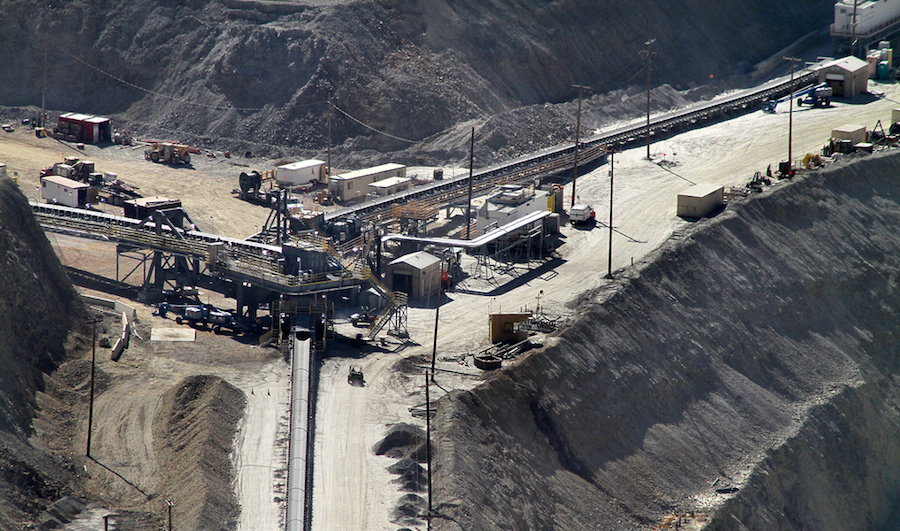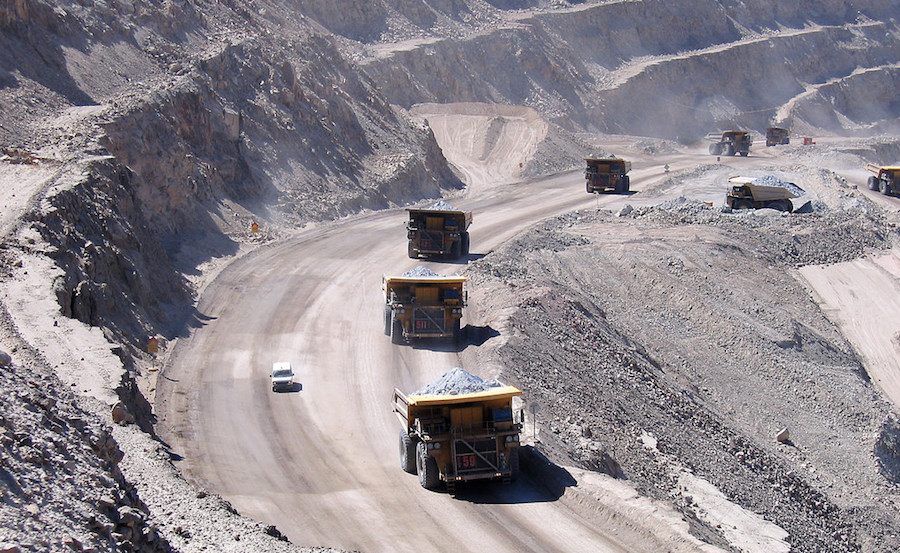
In-pit conveying system at the Kennecott Copper Mine in Utah. Creative Commons image courtesy of arbyreed.
Transporting ore and waste rock is one of the most crucial elements of an open-pit mining operation. A successful haulage system can make the difference between a mine that is consistently profitable and one that is struggling to meet its marginal costs. The downturn in commodity prices that has plagued the mining industry since 2012 has heightened the importance of haulage as a means of controlling costs as the other side of the balance sheet, declining or flat metal price revenues, continues to challenge operators, even with recent upticks in the prices of some minerals.
By some estimates, the cost of transporting materials in surface mining pits is over 50% of the total operating cost of the mine. Haul trucks are generally favoured based on their flexibility of operation compared to trains, which were the preferred method until the 1960s. Since then, technical developments have gradually led to much larger-capacity vehicles capable of hauling more ore in fewer cycles. More recently, diesel emissions regulations through the (latest) Tier 4 Final/ Stage IV standard have resulted in haul trucks that emit less pollutants while retaining performance and productivity. Telematics and GPS technology now allow haul trucks to be tracked and scheduled for maintenance with improved efficiency.
“We’ve only scratched the surface with these systems. It’s a small percentage of total mines, but it has potential to grow 10 times bigger”: Jorma Kempas, product manager, in-pit mobile solutions with Metso
Yet despite their advantages which include a perceived bias as a familiar and proven way of moving rock, haul trucks are expensive. Roads need to be constructed and maintained, trucks break down, and they require experienced drivers who are paid well especially when accruing overtime. Mining trucks also consume a lot of diesel fuel and other fluids in their regular course of operation.
In light of these challenges, in-pit crushing and conveying (IPCC) is a technology that has grown in popularity since it was first implemented in the 1950s. The purpose of an IPCC system is to allow the ore to be crushed in the pit and transported out using a conveyor system. In-pit crushers can be mobile – which means they can be moved within days or even hours, depending on their size, complexity and the relocation distance – or semi-mobile, referring to units that are more permanent and need to be moved less frequently – typically every one to 10 years. The specific configuration of course depends on the mine plan.
There are several advantages of an IPCC over a haul truck system. The first and most obvious is a marked reduction in costs due to less need for road and truck maintenance, along with significantly less fuel use and labour costs (a small number of haul trucks are retained in an IPCC operation). IPCC systems are usually reliable, requiring less maintenance and service employees than trucks, and are not impaired by bad weather.
They can also operate at grades around 30% compared to trucks which are generally restricted to maximum grades of 10%. According to the Encyclopedia of Occupational Health and Safety, using steeper grades lowers the need to remove low-grade overburden and may reduce the requirement to build high-cost haulage roads. Conveyor systems are often integrated into bucket wheel shovels in many coal-mining operations, thus eliminating the need for haul trucks. Lastly, an IPCC system may be chosen over haul trucks in mines or quarries that are close to human populations, where noise and dust may be an issue.
A representative from Metso, one of the world’s largest providers of crushing solutions for the mining and aggregates industries including IPCCs, said the main driver for a mine considering purchasing an IPCC system is cost savings.
Jorma Kempas, product manager, in-pit mobile solutions with Metso, told MINING.com in a recent interview that mines that adopt an IPCC system are looking at savings of 20 to 40% over a truck haulage system, depending on productivity rates and whether the trucks are hauling aggregates or mineral ore. For aggregate mines, where production rates are lower than metal mines, cost savings are in the 20-25% range over a 10 to 15-year mine life, including operational and capital costs. Metal mines have the potential to save more, in the range of 30 to 40%, and have a shorter payback period than aggregate mines because they have higher productivity, despite having a higher investment cost compared to haul trucks, especially in brownfield operations that already have a fleet.
Kempas noted that tonnages need to be high enough for an IPCC system to make sense, typically greater than half a million tonnes a year.
Given the significant cost savings, then, why don’t more mines use IPCC systems, which despite being around for over 60 years, are still only used in a small percentage of operations, including the recently-opened S11D iron ore mine in Brazil?
According to Kempas, it all comes down to logistics. Setting up an IPCC system makes the operation more “permanent”, versus haul trucks which can be easily deployed to any part of the pit or site. That’s especially true for mine development. Their relative lack of mobility also means IPCCs require a lot more forward planning, right from the mine’s inception. And when an IPCC is inserted into a brownfield operation, there may need to be a lot of adjustments made to the mine plan. IPCCs work well where there is horizontal movement of the mine faces, but not so great in deep mines with a lot of benches. Given these barriers, it’s easy to see why many mine operators might choose to go with a known quantity: haul trucks. Still, Kempas says the potential for IPCC is huge, where they can work:
“We’ve only scratched the surface with these systems. It’s a small percentage of total mines, but it has potential to grow 10 times bigger,” he said. “We need more reference cases; the mines want to play it safe.”
He noted that even though now might be a good time for a mine to switch from a haul truck system to an IPCC – when equipment prices are down and delivery times are shorter compared to the mining boom of a few years ago – a lot of operators are waiting to see what happens to mineral prices before committing to an investment.

Mining trucks at Codelco’s Chuquicamata copper mine in Chile. Haul truck fleets are more flexible than IPCC systems, but are expensive to operate. Creative Commons image courtesy of Magnus von Koeller.
A good example of a case where an IPCC system worked well, is the Altay Polimetally LLP mine in Kazakhstan. The greenfield copper mine was well-suited to an IPCC, with targeted annual production of between 3 and 8 million tonnes of waste rock at full output; and being a new mine, no existing haul truck fleet.
In 2012 Metso sold the world’s largest mobile crushing plant to Altay Polimetally LLP. The 11-million-euro contract included a nearly 400-ton Lokotrack LT200 mobile jaw crusher – the biggest ever built – with a nominal capacity of 2,500 tons per hour. The whole 800-ton system is electrically driven, designed to withstand temperatures from -35 to +35C.
Blasted copper ore is fed using Metso’s MAF210 mobile apron feeder to the Lokotrack LT200 jaw plant, and then conveyed using a Nordberg LL16 mobile conveying system, and track-mounted stacker to the mine’s conveyor network.
In 2013 Metso received two repeat orders that included the design, supply, installation and commissioning of secondary, tertiary and quaternary crushing and screening plants as well as an automation system – for a combined value of 25 million euros.
Four years later, Kempas said the giant mobile crusher is performing well. It has exceeded the original design capacity and now has a peak capacity of 3,200 tonnes an hour, depending on the feed gradiation that passes through the grizzly feeder head.
“This is a unique application because to my knowledge this is the first mobile IPCC that is crushing both ore and waste with a single machine,” he said, adding “It was maybe an easy decision [for the mine] because the cost-benefit is clear.”
On that point, the Altay contract was a little bit different for Metso in that the mine knew what equipment it wanted and it was really just a matter of designing the order according to the customer’s specifications, says Kempas.
More often the mine needs to do a detailed cost-benefit analysis of different crushing and transportation options, usually employing a consultant to do the leg work. Metso will offer their expertise as to what might work best, then the consultant will write a report with a recommendation for the mine.
Like most decisions involving a major capital expenditure, the devil is in the details, and it is up to Metso to prove that their systems will not only work, but save the mine money spread out over the life of the operation and the equipment.
Here Kempas reiterated the importance of logistics, stating that if the IPCC system is workable, it’s usually in the best interests of the mine to implement it:
“The bottom line is, if it’s possible to replace the trucks with conveyor haulage, most likely there will be significant cost savings. This is a proven fact in the industry,” he said. “It’s a question if the system can be used or not? If it can be used there will be cost savings. So that’s reason enough for mines to look at it more and more.”
Comments
Anon-Y-Mous-e
speaking of changing the way things are being done in mining, check out thermal fragmentation mining — its off the chain better for chasing narrow veins than blasting, see article http://miningmarketwatch.net/nip.htm thermal fragmentation surgically searches for the hardest rock (quartz) and spalls it leaving waste behind.